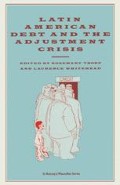Abstract
Four events of unusual significance for Central America occurred in 1979: oil prices rose sharply, world interest rates started to increase, the Sandinista-led revolution succeeded in overthrowing Somoza’s government in Nicaragua, and General Romero was ousted in El Salvador. The first two events had a direct impact on the region’s external payments, but the other two (although usually viewed in political or even geopolitical terms) also had a profound influence on the regional balance of payments. In the years after 1979, each republic at one time or another experienced a major problem of external disequilibrium, and it is for this reason that the title of this chapter refers to the balance-of-payments crisis in the singular.
Access this chapter
Tax calculation will be finalised at checkout
Purchases are for personal use only
Preview
Unable to display preview. Download preview PDF.
Notes
See Table I in Bulmer-Thomas, V., ‘World Recession and Central American Depression — Lessons from the 1930s for the 1980s’, in E. Durán, Latin America in the World Depression (Cambridge: CUP, 1985).
This point is made very clearly in Bird, G., ‘Balance of Payments Policy’, in T. Killick (ed.) The Quest for Economic Stabilisation (London: Heinemann, 1984).
The programme is described in Ministerio de Hacienda, ‘La Reforma Financiera en Costa Rica’, Banco Central de Costa Rica: Serie ‘Comentarios Sobre Asuntos Económicos’, no. 37, 1980.
It is discussed more critically in Rivera Urrutia, E., El Fondo Monetario Internacional y Costa Rica, 1978–82 (San José: Colección Centroamérica, 1982).
See Table III in Bulmer-Thomas, V. (1985), ‘World Recession’.
For the former, see Siri, G. and Raul Dominguez, L., ‘Central American Accommodation to External Disruptions’, in W. Cline (ed.) World Inflation and the Developing Countries (Washington: Brookings Institution, 1981)
for the latter, see Bulmer-Thomas, V., ‘A Model of Inflation for Central America’, Bulletin of the Oxford University Institute of Economics and Statistics, November 1977
For a similar argument, see Tseng, W., ‘The Effects of Adjustment’, Finance and Development, December 1984.
See Weinert, R., ‘Nicaragua’s Debt Renegotiation’, Cambridge Journal of Economics, vol. 5, 1981, pp. 187–94.
The charge that the agreement was politically motivated has been made by several observers; see, for example, Arias Penate, S., El FMI y la Política Contrainsurgente en El Salvador, Cuadernos de Pensamiento Propio (Managua: INIES, 1983).
There is a good description of the scheme in Carlos H. González A., ‘Experiencia de Guatemala con el Proceso de Ajuste en 1982–3’, in Centro de Estudios Monetarios Latinoamericanos, Boletín, vol. XXX, no. 3, May–June 1984, pp. 157–65.
See Feinberg, R. and Newfarmer, R., ‘The CBI: Bold Plan or Empty Promise?’, in R. Newfarmer (ed.) From Gunboats to Diplomacy (Baltimore: Johns Hopkins, 1984).
See Crawford, M., ‘Third World Debt is Here to Stay’, Lloyds Bank Review, January 1985.
See Banco Interamericano de Desarrollo, Informe Económico — Nicaragua, October 1974, Table 12.
See Austin, J., Fox, J. and Kruger, W., ‘The Role of the Revolutionary State in the Nicaraguan Food System’, World Development, January 1985, pp. 15–40.
See Stahler-Sholk, R., ‘Debt and Stabilization in Revolutionary Nicaragua’, paper presented at XII Conference of the Latin American Studies Association, Albuquerque, New Mexico, April 1985.
See IMF, International Financial Statistics, July 1985.
See Inforpress, Centroamericana, no. 643, 6 June 1985, p. 13.
See Inforpress, Centroamericana, no. 649, 18 July 1985, p. 8.
See Inforpress, Centroamericana, no. 650, 25 July 1985, p. 3.
See Inforpress, Centroamericana, no. 647, 4 July 1985, p. 2.
See Inforpress, Centroamericana, no. 642, 30 May 1985, p. 6.
See PREALC, Producción de Alimentos Básicos y Empleo en el Istmo Centroamericano, Santiago, August 1983, Table 5.
See Bulmer-Thomas, V., ‘Central America in the Inter-War Years’, in R. Thorp (ed.) Latin America in the 1930s: the Periphery in World Crisis (London: Macmillan, 1984).
See CBI, Business Bulletin, June 1985, p. 2.
Although the ratio of tax revenue to GDP is the lowest in Latin America outside Haiti, cuts in public expenditure have prevented an explosion in the PSBR which fell by 47 per cent between 1981 and 1984 (see Inforpress, Centroamericana, no. 646, 27 June 1985, p. 2).
See, for example, many of the articles in G. Irving and X. Gorostiaga (eds) Towards an Alternative for Central America and the Caribbean (London: Allen & Unwin, 1985).
Including Nicaragua; a list of socialist country loans/grants to Nicaragua can be found in Acciaris, R., ‘Nicaragua — Pays Socialistes; vers la consolidation des liens économiques?’, Problèmes d’Amérique Latine, no. 74, 1984. Mexico has also been a very important creditor.
Editor information
Editors and Affiliations
Copyright information
© 1987 Rosemary Thorp and Laurence Whitehead
About this chapter
Cite this chapter
Bulmer-Thomas, V. (1987). The Balance-of-Payments Crisis and Adjustment Programmes in Central America. In: Thorp, R., Whitehead, L. (eds) Latin American Debt and the Adjustment Crisis. St Antony’s/Macmillan Series. Palgrave Macmillan, London. https://doi.org/10.1007/978-1-349-18671-6_9
Download citation
DOI: https://doi.org/10.1007/978-1-349-18671-6_9
Publisher Name: Palgrave Macmillan, London
Print ISBN: 978-0-333-42649-4
Online ISBN: 978-1-349-18671-6
eBook Packages: Palgrave Economics & Finance CollectionEconomics and Finance (R0)

